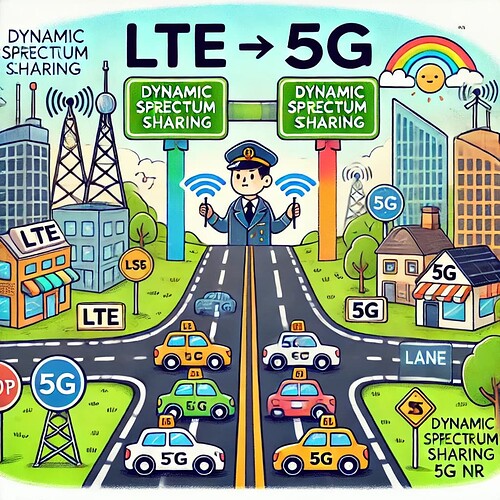This topic presents in a very simplified way all the main concepts that should be understood by those who know 5G NR.
5G NR Dynamic Spectrum Sharing
Dynamic Spectrum Sharing (DSS) is a technology that enables 4G LTE and 5G New Radio (NR) to share the same frequency band dynamically. It works by analyzing real-time demand for 4G and 5G, dynamically allocating spectrum resources between the networks based on usage needs, and seamlessly switching devices between LTE and 5G coverage as traffic demands change. DSS is a critical milestone in the 5G roadmap, allowing mobile operators to optimize limited frequency resources, introduce 5G services without acquiring new spectrum, and ensure the coexistence of 4G and 5G. It guarantees full backward compatibility, ensuring LTE devices remain unaffected. By facilitating a smooth transition between technologies, DSS helps operators address evolving user needs while maximizing spectrum efficiency.
![]() Dynamic Spectrum Sharing (DSS) is like two cities, LTE City and 5G City, sharing the same big road. The road has multiple lanes, and DSS acts like a smart traffic controller. It watches how many cars (people using LTE or 5G) are on the road in real time. If LTE City has more cars, DSS gives them more lanes, and if 5G City gets busy, it shifts some lanes to them. The cool part is that it doesn’t block or slow down traffic for anyone - everyone gets to use the road smoothly. This way, both cities can grow and work together without needing to build a brand-new road, keeping everyone happy and moving efficiently! [In a Nutshell: DSS is like a smart road that adjusts lanes for two cities, LTE and 5G, to keep traffic flowing and everyone satisfied.]
Dynamic Spectrum Sharing (DSS) is like two cities, LTE City and 5G City, sharing the same big road. The road has multiple lanes, and DSS acts like a smart traffic controller. It watches how many cars (people using LTE or 5G) are on the road in real time. If LTE City has more cars, DSS gives them more lanes, and if 5G City gets busy, it shifts some lanes to them. The cool part is that it doesn’t block or slow down traffic for anyone - everyone gets to use the road smoothly. This way, both cities can grow and work together without needing to build a brand-new road, keeping everyone happy and moving efficiently! [In a Nutshell: DSS is like a smart road that adjusts lanes for two cities, LTE and 5G, to keep traffic flowing and everyone satisfied.]
Skip to: Roadmap to 5G NR
Dynamic Spectrum Sharing
Dynamic Spectrum Sharing (DSS) is a technology that enables 4G LTE and 5G New Radio (NR) to share the same frequency band dynamically. It works by analyzing real-time demand for 4G and 5G, dynamically allocating spectrum resources between the networks based on usage needs, and seamlessly switching devices between LTE and 5G coverage as traffic demands change. DSS is a critical milestone in the 5G roadmap, allowing mobile operators to optimize limited frequency resources, introduce 5G services without acquiring new spectrum, and ensure the coexistence of 4G and 5G. It guarantees full backward compatibility, ensuring LTE devices remain unaffected. By facilitating a smooth transition between technologies, DSS helps operators address evolving user needs while maximizing spectrum efficiency.
![]() Dynamic Spectrum Sharing (DSS) is like two cities, LTE City and 5G City, sharing the same big road. The road has multiple lanes, and DSS acts like a smart traffic controller. It watches how many cars (people using LTE or 5G) are on the road in real time. If LTE City has more cars, DSS gives them more lanes, and if 5G City gets busy, it shifts some lanes to them. The cool part is that it doesn’t block or slow down traffic for anyone - everyone gets to use the road smoothly. This way, both cities can grow and work together without needing to build a brand-new road, keeping everyone happy and moving efficiently! [In a Nutshell: DSS is like a smart road that adjusts lanes for two cities, LTE and 5G, to keep traffic flowing and everyone satisfied.]
Dynamic Spectrum Sharing (DSS) is like two cities, LTE City and 5G City, sharing the same big road. The road has multiple lanes, and DSS acts like a smart traffic controller. It watches how many cars (people using LTE or 5G) are on the road in real time. If LTE City has more cars, DSS gives them more lanes, and if 5G City gets busy, it shifts some lanes to them. The cool part is that it doesn’t block or slow down traffic for anyone - everyone gets to use the road smoothly. This way, both cities can grow and work together without needing to build a brand-new road, keeping everyone happy and moving efficiently! [In a Nutshell: DSS is like a smart road that adjusts lanes for two cities, LTE and 5G, to keep traffic flowing and everyone satisfied.]
- Search Forum
 5G NR Dynamic Spectrum Sharing
5G NR Dynamic Spectrum Sharing 
Quick Summary
- Dynamic Spectrum Sharing: Enables 4G and 5G networks to share spectrum efficiently, optimizing resource usage and facilitating a smooth transition to 5G. (DSS is like a smart road sharing lanes between LTE and 5G to keep traffic flowing smoothly.)
That’s it. ![]()
-
Continue reading: Roadmap to 5G NR - UE Identities
-
Or back to: Roadmap to 5G NR

